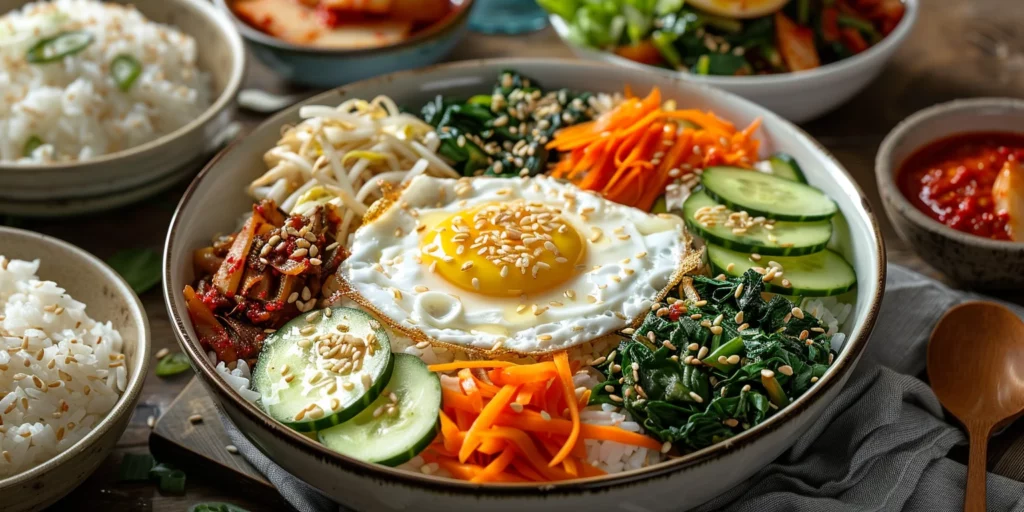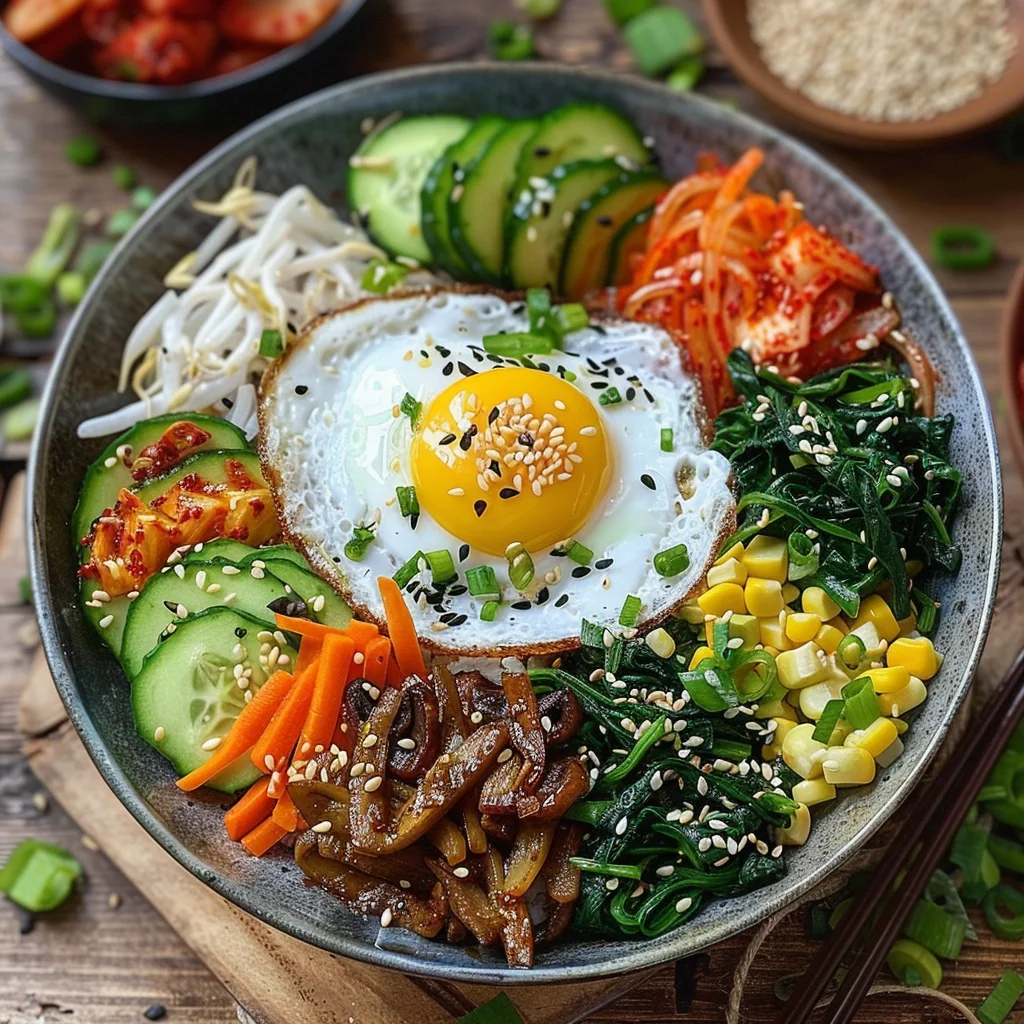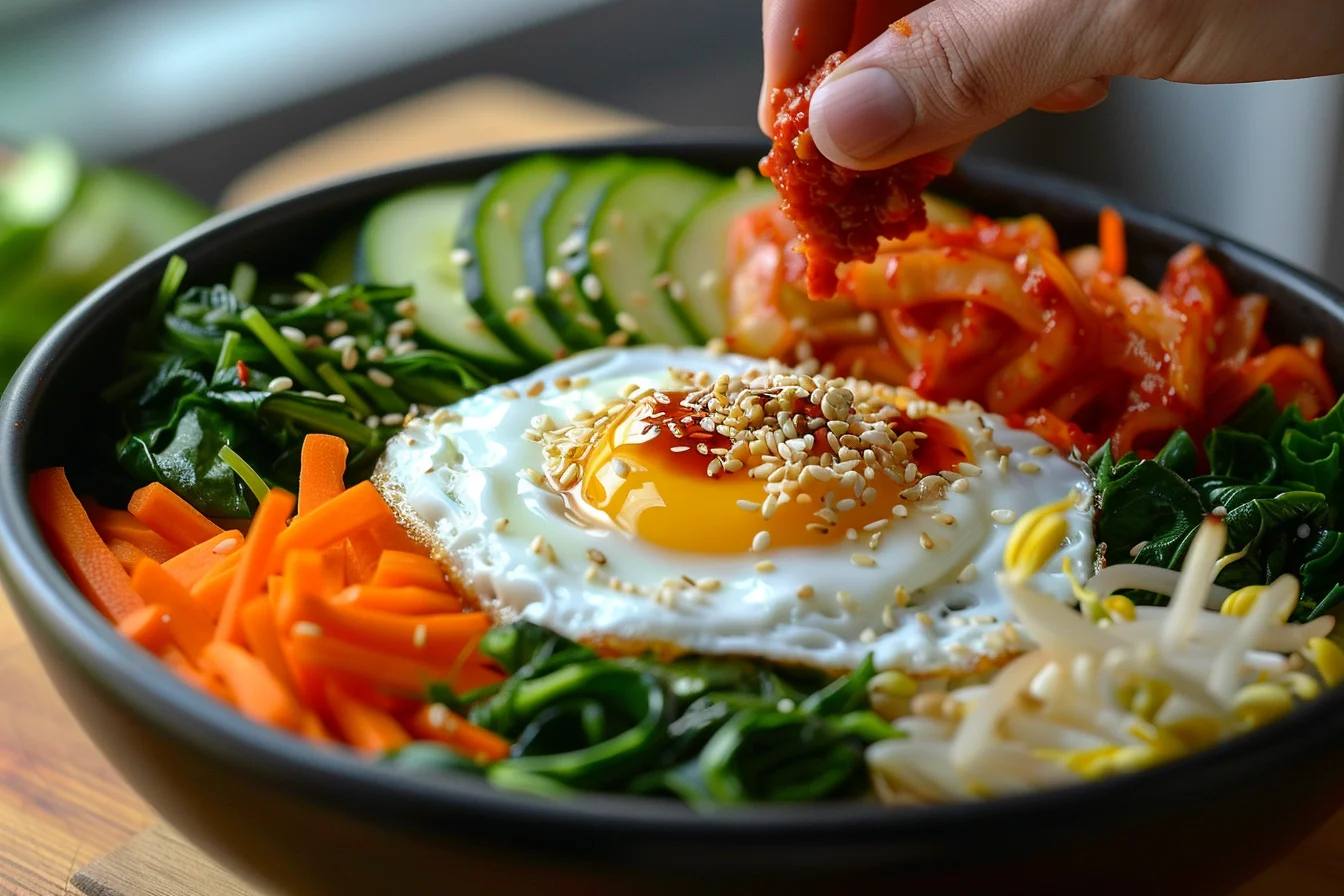Bibimbap is a traditional Korean dish that translates to “mixed rice.” It consists of a bowl of warm white rice topped with sautéed and seasoned vegetables, gochujang (chili pepper paste), and often a fried egg and sliced meat. The ingredients are stirred together thoroughly just before eating.
The combination of fresh vegetables, savory beef, and spicy gochujang creates a dish that is both hearty and delicious. Making Bibimbap at home allows you to enjoy this popular Korean dish with fresh ingredients and the perfect balance of flavors.
Whether you’re familiar with Korean cuisine or trying it for the first time, Bibimbap is sure to become a favorite. Serve it with a side of kimchi for a complete and satisfying meal.
Bibimbap Recipe
Ingredients
For the Bibimbap:
- 4 cups cooked short-grain rice
- 12 ounces soybean sprouts washed and drained
- 8 ounces spinach blanched and washed with excess water squeezed out
- 1 medium carrot cut into matchsticks
- 1 medium zucchini cut into matchsticks
- 1 red bell pepper sliced into strips
- 1 cucumber thinly sliced
- 8 ounces shiitake mushrooms sliced
- 1 tablespoon vegetable oil
- 1 tablespoon sesame oil
- 1 tablespoon soy sauce
- 1 teaspoon minced garlic
- 1 teaspoon sesame seeds
- 4 eggs optional
- Gochujang Korean chili pepper paste
For the Beef (optional):
- 200 grams beef cut into matchsticks
- 1 tablespoon soy sauce
- 1 tablespoon minced garlic
- 1 tablespoon honey
- 2 teaspoons sesame oil
- 1 teaspoon sesame seeds
Instructions
Step 1: Prepare the Vegetables
- Soybean Sprouts: Put the soybean sprouts in a pot with 4 cups of water and 2-3 teaspoons of salt. Cover and cook for 20 minutes over medium-high heat. Drain and mix with 1 teaspoon minced garlic, 2 teaspoons toasted sesame oil, and ½ teaspoon salt. Set aside.
- Spinach: Cut the blanched spinach a few times and mix with 1 teaspoon minced garlic, 1 teaspoon toasted sesame oil, ½ teaspoon salt, and 1 teaspoon sesame seeds. Set aside.
- Carrot: Mix the carrot matchsticks with a pinch of salt and let stand for 5-10 minutes until sweating. Sauté in a pan with a little oil until tender. Set aside.
- Zucchini: Mix the zucchini matchsticks with ½ teaspoon salt and let stand for 5-10 minutes. Sauté in a pan with a little oil until tender. Set aside.
- Red Bell Pepper: Sauté the red bell pepper strips in a pan with a little oil until tender. Set aside.
- Cucumber: Mix the cucumber slices with ¼ teaspoon salt and let stand for 5-10 minutes. Set aside.
- Shiitake Mushrooms: Sauté the sliced mushrooms in a pan with a little oil until tender. Set aside.
Step 2: Prepare the Beef (Optional)
- Mix the beef with 1 tablespoon soy sauce, 1 tablespoon minced garlic, 1 tablespoon honey, 2 teaspoons sesame oil, and 1 teaspoon sesame seeds. Marinate for 30 minutes.
- Sauté the marinated beef in a pan until cooked through. Set aside.
Step 3: Cook the Eggs (Optional)
- Fry the eggs sunny side up in a pan with a little oil. Set aside.
Step 4: Assemble the Bibimbap
- Divide the cooked rice into 4 bowls.
- Arrange the prepared vegetables and beef (if using) on top of the rice in sections.
- Place a fried egg (if using) on top of each bowl.
- Add a tablespoon of gochujang to each bowl.
- Sprinkle with sesame seeds and drizzle with sesame oil to taste.
Step 5: Serve
- Serve the Bibimbap with additional gochujang on the side.
- Mix all the ingredients together before eating.
Tips and Information
- Rice: Use short-grain rice for the best texture. Brown rice or cauliflower rice can be used as alternatives.
- Vegetables: Feel free to use any vegetables you like or have on hand. Steamed or sautéed cabbage, bok choy, or daikon would be great additions.
- Serving: Bibimbap can be served in a regular bowl or a hot stone bowl (dolsot) for a crispy rice texture.

Preparing Bibimbap in your own kitchen allows you to savor the authentic taste of this traditional Korean dish. The freshly made vegetables and rich flavors give the Bibimbap a unique taste that is sure to impress.
Serve it hot with a side of salad for a complete and hearty meal.


